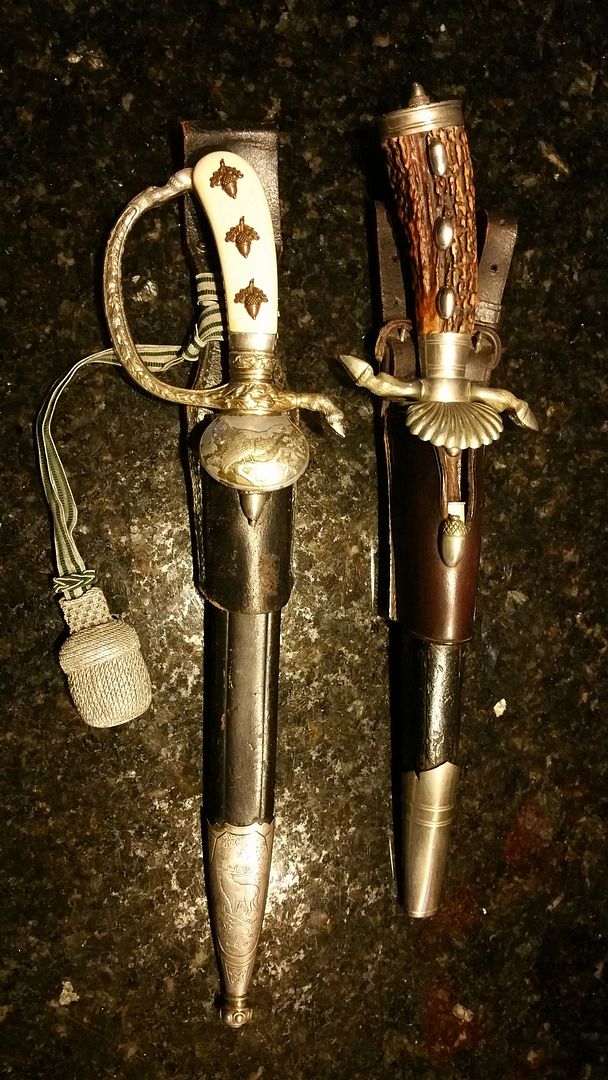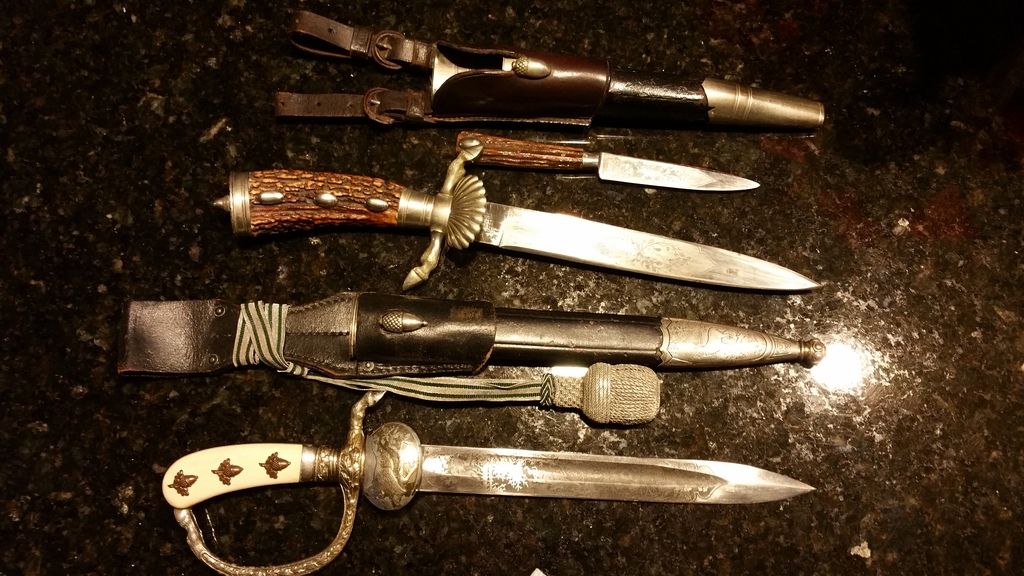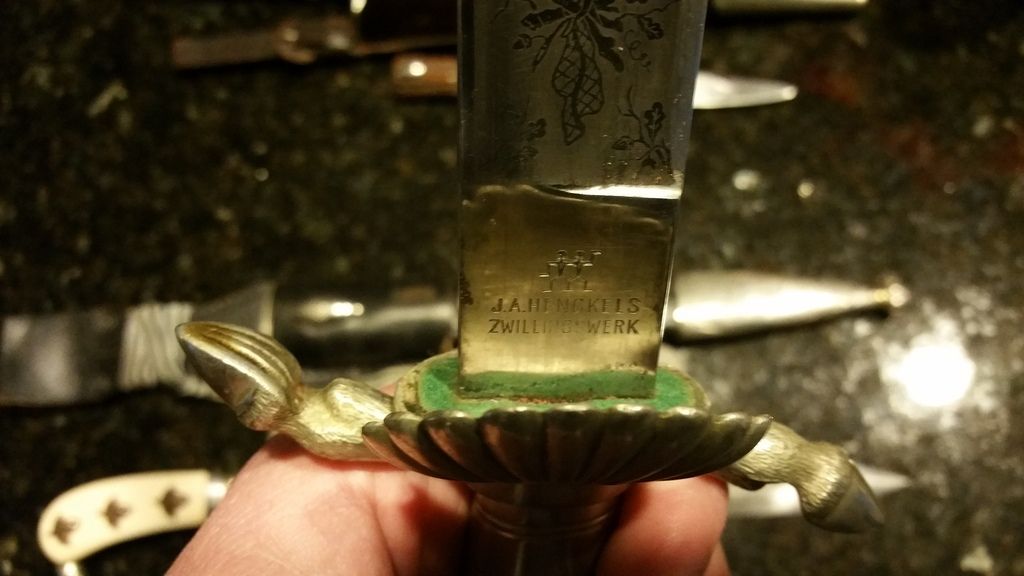Announcement
Collapse
No announcement yet.
German Forestry Knives
Collapse
X
-
These two Hirschfänger = stag killers = hunting daggers follow the shapes of the Prussian models, once prescribed as part of the forester's uniforms and indicating rank as well. The one with the handguard and "ivory" grips was for higher ranking officers like Forstmeister (ranks requiring an university master degree). The other one, with the staghorn handle, was prescribed for the lowest ranks, forest rangers and juniors. There was a third type too, for middle ranks, like the one for higher ranks, but with stag instead of" ivory" scales to the grip.
As the blades are already rather short, both knifes are certainly post – 1900, most likely of 1930s date. The low rank one, with the gutting knife, "Nicker", attached in the fashion from medieval times on, looks reasonably businesslike, while the other is a typical "uniform ornament". During the 1920s and 30s there was a movement again to reanimate the use of cold steel for the coup de grace on deer and boar, which also led to the invention of both Lippert's and Frevert's Waidblatt.
Such Hirschfänger were worn by foresters with the dress uniforms on formal occasions up to WW2, but are out of fashion since. This does not stop Schuetzen, who often ape older forester uniforms, to wear them, sometimes the old official models, more often fancy but practically unuseable ones.
The knifes were made by two still existing Solingen (= the German "Sheffield") cutlery companies, J.A.Henckels "Zwillingswerke" (Zwilling = twin), http://www.zwillingonline.com/ , and Eickhorn (Eichhorn = squirrel), http://www.eickhorn-solingen.de/epag...ops%2F62631327Last edited by Axel E; 12-24-2015, 12:23 AM.
-
Here is a pic from G. Seifert's book "Der Hirschfänger". It shows the Royal Prussian forester uniforms as prescribed in 1868. You can see 3 types of Hirschfänger, as prescribed then for the ranks, albeit still with the much longer 19th century blades. From left:
Forester in service dress: Green jacket, grey trousers. Green – grey felt hat with green band and brass Prussian eagle and horn. Hirschfänger with crossguard and stag handle.
Superior forester, Forstmeister, in dress uniform. Jacket with embroidery on collar and cuffs, white trousers, Hirschfänger with "ivory" grip scales and bow guard.
Head of provincial forest department and up, in full ceremonial dress. Jacket embroidered on chest too, ceremonial Hirschfänger with bow guard, ivory scales and eagle's head (obsolete by 1900).
 Last edited by Axel E; 12-25-2015, 11:29 AM.
Last edited by Axel E; 12-25-2015, 11:29 AM.
Comment
-
These are all very fine pieces of cutlery but I don't know much at all about this style of knife. Is there any special symbolism attached to the decorations on the knives? Like the three acorns and things like that. Also what is the purpose of the curved section on the top of the blades? Is it sharpened?
Thanks, Diz
Comment
-
From a previous posting on the Lippert waidblatt
"Extracted from previous post is some info gathered while searching for info on the "Lippertsche Waidblatt" 1936 patent retailed by Heinrich Scherpings shop, & the replics's created by Willi Ulrich of Solingen in 2001, note comments on the blade design. The PUMA is also a very fine Knife that has been held in high esteem for quite some time.
He was featured in Time magazine August 20/27 2001 “Why Europes craftsmen are still the best” with a story on him named “The daily grind German Sword Grinder Willi Ulrich” This special hunting knife was designed by by renowned artist & hunter F. K. Lippert and he registered the patent application in 1936 for the Lippertsches Waidblatt. In 2001 Willi Ulrich decided to revive this hunting collection of knives & tools into a special production of 200 Replica’s as only about 12 originals bore Scherpings name and were sold from his shop & only a handful of originals have been viewed. This replica was delivered in precise detail, each presentation box set is uniquely numbered and contains the “Lippertsche Waidblatt” & a smaller skinning knife & a bone marrow awl/sharpening steel, all contained in a fitted leather sheath. We have been able to obtain the advertisement from “Wild und Hund” hunting magazine 1937 as well as the artists concept drawing & the patent application provided with the Ulrich set. Another article penned by author Richard Schmeider titled “The Lipper Chechen Waidblatt, Rare and sought after” The Waidblatt to Upper Forest Master Walter Frevert is the Classic among Blank hunting weapons. The Frederick Karl Lippert, however, know the least, but it had real benefits in practical use for hunting.
“In October 1936 the painter and hunter Friedrich Karl Lippert the Patent Office Berlin a very special Waidblatt, which is the usual and widespread Frvertschen Waidblatt for interception of pigs was superior and much easier for the firm Sauschwarte penetrated. With the double curvature of the sharpened blade back in place (blade tip) Lippert wanted to ensurethat the blade not only the penetration into the wild body but alsothe withdrawal of blood by separation and thus a greater sweat loss vewirkte. Furthermore Lippertschen Waidblatt fell when the finger at the artistic in the form of a wolf angel was designed. The leaf blades had a length of 230 millimeters, was at the head are 38 mm and a maximum at the place from 42 to 44 mm wide. His back was 5 mm thickness-ter, in its center, on the other hand, it was a massive 6.5 mm thick.
Enthusiastic supporters: Upper forrest FrieB
The Lipper Tschechen sheet was up to almost half of his double-blade length so that the blade on the interception of wild game was ideally suited. Upper Forest master Rudolf Friess had once in his Saujagden in the Sessart such Lipper Tsches Waidblat in use and was excited. FrieB mistaken, however, when he saw a reproduction of the althannover’s Couteaus held. When the latter was merely a short deer catcher with a straight blade. Elaborate handmade to order. Lippert design, however, never reached the popularity level of Frevertschen Waidblatts. The vinous specimens that used by the company in Hannover, Heinrich Scherping only available to order in an exclusive handicraft were made are now difficult to find and more popular collection items”
More from the Ulrich documentation
Why is the Lippertsche Waidblatt going to be reproduced?
The precision of a drawn barrel is unique.
Following this the developed steel blade, has a blade length of approximately 23-25 cm, has a width of 5 cm, the back strength is 5mm, is double edged with a rounded point and so preventing the piercing of ribs and periosium, in addition to the thrust into soft organs (heart/lungs) The heart does not need to be penetrated, as death is caused by air in the thoraxic cavity, causing imminent and painless.
These are quotations from the book of F. Karl Lippert which appeared in 1954
“Vom SchuB an” Osterwald Verlag Hannover/Germany
The for and against if interception with the Waidblatt was for the maker of “Lippert Waidblatt” unequivocal.
Some comments from an area hunter
Therefore this matter of killing a wounded animal has many supporters, so the “Lippertsche Waidblatt” is even today still actual. The coup de grace from the barrel is quite in frequent, therefore fast cold steel is a necessity. For this use the LippertscheWaidblatt , developed by F.K. Lippert, is unequalled by causing air embolisum instantly, even through thick Boar skin, as recommended by well known Forestry Commissioneer Rudolf Fries in the 50s, who’s experience in the past was gathered by numerous Boar hunts.
With the present increase of wild Boar hunting, the “Lippertsche Waidblatt” is the best cold steel weapon. October 2001 Richard Schneider"
Comment
-
From a previous posting on the Lippert waidblatt
"Extracted from previous post is some info gathered while searching for info on the "Lippertsche Waidblatt" 1936 patent retailed by Heinrich Scherpings shop, & the replics's created by Willi Ulrich of Solingen in 2001, note comments on the blade design. The PUMA is also a very fine Knife that has been held in high esteem for quite some time.
He was featured in Time magazine August 20/27 2001 �Why Europes craftsmen are still the best� with a story on him named �The daily grind German Sword Grinder Willi Ulrich� This special hunting knife was designed by by renowned artist & hunter F. K. Lippert and he registered the patent application in 1936 for the Lippertsches Waidblatt. In 2001 Willi Ulrich decided to revive this hunting collection of knives & tools into a special production of 200 Replica�s as only about 12 originals bore Scherpings name and were sold from his shop & only a handful of originals have been viewed. This replica was delivered in precise detail, each presentation box set is uniquely numbered and contains the �Lippertsche Waidblatt� & a smaller skinning knife & a bone marrow awl/sharpening steel, all contained in a fitted leather sheath. We have been able to obtain the advertisement from �Wild und Hund� hunting magazine 1937 as well as the artists concept drawing & the patent application provided with the Ulrich set. Another article penned by author Richard Schmeider titled �The Lipper Chechen Waidblatt, Rare and sought after� The Waidblatt to Upper Forest Master Walter Frevert is the Classic among Blank hunting weapons. The Frederick Karl Lippert, however, know the least, but it had real benefits in practical use for hunting.
�In October 1936 the painter and hunter Friedrich Karl Lippert the Patent Office Berlin a very special Waidblatt, which is the usual and widespread Frvertschen Waidblatt for interception of pigs was superior and much easier for the firm Sauschwarte penetrated. With the double curvature of the sharpened blade back in place (blade tip) Lippert wanted to ensurethat the blade not only the penetration into the wild body but alsothe withdrawal of blood by separation and thus a greater sweat loss vewirkte. Furthermore Lippertschen Waidblatt fell when the finger at the artistic in the form of a wolf angel was designed. The leaf blades had a length of 230 millimeters, was at the head are 38 mm and a maximum at the place from 42 to 44 mm wide. His back was 5 mm thickness-ter, in its center, on the other hand, it was a massive 6.5 mm thick.
Enthusiastic supporters: Upper forrest FrieB
The Lipper Tschechen sheet was up to almost half of his double-blade length so that the blade on the interception of wild game was ideally suited. Upper Forest master Rudolf Friess had once in his Saujagden in the Sessart such Lipper Tsches Waidblat in use and was excited. FrieB mistaken, however, when he saw a reproduction of the althannover�s Couteaus held. When the latter was merely a short deer catcher with a straight blade. Elaborate handmade to order. Lippert design, however, never reached the popularity level of Frevertschen Waidblatts. The vinous specimens that used by the company in Hannover, Heinrich Scherping only available to order in an exclusive handicraft were made are now difficult to find and more popular collection items�
More from the Ulrich documentation
Why is the Lippertsche Waidblatt going to be reproduced?
The precision of a drawn barrel is unique.
Following this the developed steel blade, has a blade length of approximately 23-25 cm, has a width of 5 cm, the back strength is 5mm, is double edged with a rounded point and so preventing the piercing of ribs and periosium, in addition to the thrust into soft organs (heart/lungs) The heart does not need to be penetrated, as death is caused by air in the thoraxic cavity, causing imminent and painless.
These are quotations from the book of F. Karl Lippert which appeared in 1954
�Vom SchuB an� Osterwald Verlag Hannover/Germany
The for and against if interception with the Waidblatt was for the maker of �Lippert Waidblatt� unequivocal.
Some comments from an area hunter
Therefore this matter of killing a wounded animal has many supporters, so the �Lippertsche Waidblatt� is even today still actual. The coup de grace from the barrel is quite in frequent, therefore fast cold steel is a necessity. For this use the LippertscheWaidblatt , developed by F.K. Lippert, is unequalled by causing air embolisum instantly, even through thick Boar skin, as recommended by well known Forestry Commissioneer Rudolf Fries in the 50s, who�s experience in the past was gathered by numerous Boar hunts.
With the present increase of wild Boar hunting, the �Lippertsche Waidblatt� is the best cold steel weapon. October 2001 Richard Schneider"
Comment
-
As you mentioned and showed Lippert's Waidblatt here reminds me about the enigmatic "Old Hanoverian Kuto". (Old Hanoverian relates to the Kingdom of Hanover, before it was annexed by Prussia as an outcome of the 1866 "needle fire war"). A "Kuto" was mantioned by some old foresters as a substantial hunting knife formerly used by Hanoverian foresters, but noone, including me, knew what such a thing looked like and where the name originated. Lippert himself claimed his Waidblatt being designed after the Kuto, but no 19th century knife resembling Lippert's is known. Friess in his books even shows Lippert's Waidblatt and calls it a "Hanoverian Kuto", without even mentioning Lippert.
Then one day an old fellow forester, Mr. St..., visited me because he wanted to sell off his now unneeded guns and wanted my advice. Mr. St. comes from a dynasty of Hanoverian foresters. Members of the St... family held a Forstamt = forest office in the Solling for six generations, exactly 222 years, from 1768 to 1990.
Mr.St. showed me a Hirschfänger and remarked: "This comes from my grandfather Carl St...".

I looked at the thing: A stout knife with a relatively short blade and stag antler grip, but not patterned after the Prussian type. The blade showed signs of heavy use and resharpening. In all, not a decorative ornament, but a well used tool of the trade. Both crossguard and sheath are crudely inscribed C. St... on the back, but not in a script in use at the Prussian service time of Carl St..., 1881 to 1921. At first glance this knife must have been older than the Prussian uniform regulations became effective in the Solling forest. So it must have been "Old Hanoverian", before 1866. Mr. St... had to go back another two generations. Indeed, there was another C.St... active at those times, a Christian St..., from 1814 to 1851.
A bit of research revealed the history and at the same time solved the mystery of the "Kuto":
The Hanoverian uniform regulations from 1792 and 1837 presribed an elaborate "Hirschfänger" with ivory grip, worn with an embroydered bandoleer over the shoulder, for the highest ranks, mostly noblemen, only. Ordinary foresters like the St...s, then ranked as "walking foresters" and "riding foresters", were not allowed to wear such a "Hirschfänger". They were merely allowed to wear a shorter "Couteau de Chasse", French for "hunting knife", with staghorn grip, with a unadorned belt, no bandoleer. St's knife fits this description, so it is such a "Couteau" or "Kuto". The simple German foresters heard how the French word "Couteau" was spoken and wrote what they heard in German letters: "Kuto"!
Meanwhile I know about several other such Kutos, some in the Celle Museum.Last edited by Axel E; 12-28-2015, 12:03 AM.
Comment
-
Axel,
All this is very interesting. I'm waiting for your answer to Diz's question. All the Hirschfangers(?)I'm familiar with have longer (short sword length) blades. I believe this was to avoid the antlers of injured Stags. I think it would help if you could also discuss this. Was it just different customs between Prussian, Hessian, Bavarian, and other State's Foresters?
Mike
Comment
-
A german state forester is usually assigned to a Revier = state forest district, once about 300 ha, but now up to 1500 ha. He is responsible to manage all aspects of his revier sustainable, according to rules and guidelines set up by superior levels of the state forest service. Sustainability = Nachhaltigkeit was invented by German foresters 300 years ago as the foremost principle of German forestry. The Revierf�rster marks the trees to be felled, superwises the forest workers, sorts the timber according to the contracts made by his superior Forstamt, organizes planting, cares for nature conservation, manages the game, organizes the hunting and has some police duties in his Revier.Originally posted by Diz View PostWhat did a Forester actually do and what were the different ranks responsible for? Thanks, Diz
So he is at the same time a forest engineer, silviculturer, landscape architect, conservationist , game manager and warden, policeman.
At Christian St.'s time the duties differed some from now. Main tasks then were patrolling the forests and fight the gangs of poachers, robbers and wood thieves that roamed the forests then. A stout fighting knife was needed sometimes as a last ditch defense. There are still two muzzleloading percussion cape guns from those times in the family, but these provided limited firepower. Some of the then duties are obsolete by now, such as supervising charcoal burners, the gluttoning of domestic pigs on acorns and the grazing of cattle in the forests.
Organization and education of foresters changed a lot over the years and from state to state. As foresters with an university degree, called Forstmeister once, were few, senior foresters were promoted, called Oberf�rster in Prussia and riding foresters in Hanover, and supervised 3 � 4 Reviere. In turn they reported to a Forstamt = forest office led by a Forstmeister. These in turn were subject to provincial forest departments and the state forest administration attached to a minister.
The forest administrations were streamlined a lot. When I started my career 40 years ago, we had 10 Forst�mter here in southern Lower Saxony, each led by a Forstmeister. Of these merely 2 are left over now.
This is maybe an oversimplification, but may be sufficient at the moment for a forum. Whole books are filled with the history of German forestry.
Comment







Comment